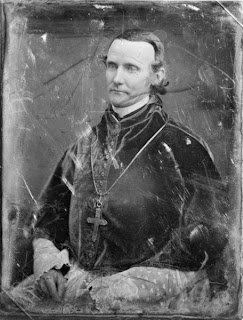The First Prince... and His Patrons
 In the midst of another historic moment at the helm of the church in New York and with St Patrick's Day soon upon us, it's especially worth noting that -- as Brooklyn diocesan archivist Pat McNamara points out on his blog -- today marks 134 years since the elevation of the first American cardinal: Gotham's second archbishop, John McCloskey.
In the midst of another historic moment at the helm of the church in New York and with St Patrick's Day soon upon us, it's especially worth noting that -- as Brooklyn diocesan archivist Pat McNamara points out on his blog -- today marks 134 years since the elevation of the first American cardinal: Gotham's second archbishop, John McCloskey.Born across the East River from Manhattan (not its own diocese until 1853), McCloskey became the first native New Yorker ordained to the priesthood in 1834 and was named coadjutor to then-Bishop John Hughes a decade later, six years before the Big Apple see was elevated to an archdiocese. Named the founding bishop of Albany three years later, he was returned south in 1864 on Hughes' death as the second archbishop of what would become the "capital of the world."
While McCloskey's fearless, Irish-born mentor -- known as "Dagger John" -- was famous in life for his bombast and remains one of American Catholic history's more celebrated figures even into the present, the successor who would outrank him was a more "quiet, self-effacing" sort who's largely faded into the din of memory.
Along these lines, both of McCloskey's standout moments essentially took place on his predecessor's shoulders.
The unprecedented American red hat -- and, for that matter, the "arrival" of Catholicism as a force in its largest city -- would've been much slower in its speed were it not for Hughes' proud, bullish corralling of the faithful, and in 1879, the cardinal dedicated the "cathedral of suitable magnificence" the first archbishop began planning three decades earlier: the "New" St Patrick's in Midtown, the enduring, iconic symbol of the Stateside church (which now, so they say, needs upwards of $100 million in immediate maintenance and repairs).
Forty-six Americans have since followed McCloskey into the Sacred College, six having had their seat at 50th and Fifth. With Archbishop Timothy Dolan formally joining the line as McCloskey's eighth successor and the city's 13th ordinary on 14 April, the now-retired ninth archbishop, Cardinal Edward Egan, penned a piece on the first prince early last year in the archdiocesan weekly:
Shortly after I was named to the College of Cardinals in 2001, a dear friend gave me a colored Currier and Ives lithograph beautifully framed. It was entitled in large letters, "Imposing the Cardinal's Berretta," and in small ones, "Upon His Grace Archbishop McCloskey of New York, by His Grace, Archbishop Bayley of Baltimore, at [Old] St. Patrick's Cathedral, N.Y., April 27th, 1875." Under the image in even smaller letters one could read, "Published by Currier and Ives, 115 Nassau St., New York."In keeping with tradition, with another cardinal-archbishop looking on from its steps, the cathedral McCloskey dedicated will be the centerpiece of Gotham's St Patrick's Day parade -- the largest in the world -- which'll be held for its 248th time on Tuesday's feast of the apostle of Ireland, the patron of the New York church.
The lithograph depicted a clergyman in a black cassock and a black shoulder cape with eyes cast down, over whose bowed head an imposing prelate in a bishop's cope and miter held a "birettum," the classic head covering of the Catholic clergy until the early 1960s.
I studied the lithograph and wondered if John Cardinal McCloskey, about whom I knew virtually nothing, was as humble and unprepossessing a fellow as the artist's representation suggested. In due course, I discovered that he was....
There are many achievements of the first American Cardinal that could be listed here. However, in the interest of understanding the kind of person he was, perhaps it is best to recall just two anecdotes about him. The first comes from the pen of the second American Cardinal, James Cardinal Gibbons [of Baltimore], who wrote of McCloskey: "A few minutes before he was to ascend the pulpit to deliver the opening address at the Second Plenary Council of Baltimore, a telegram was handed to him announcing the destruction of his Cathedral by fire. His Eminence preached in his usual tranquil and unruffled manner. When I expressed to him the next morning my surprise at his composure, he replied: 'The damage was done, and I could not undo it.'"
The second anecdote is perhaps even more revealing.
William Tecumseh Sherman, the Civil War general who led the bloody "March to the Sea," had a son who wanted to study to be a Jesuit. Sherman wrote a letter to McCloskey telling him to dissuade his son from such an unthinkable course of action. The Cardinal met with young Sherman, listened to his story and encouraged him in his vocation. The General contacted the editor of a St. Louis newspaper, condemned the Cardinal in the most offensive terms and accused him of robbing him of a son. The editor telegrammed the Cardinal for a comment. The reply was classic McCloskey: "General Sherman's letter was marked 'personal and confidential." " And he never mentioned the matter again.
I looked once more at the little figure in the Currier and Ives lithograph with his eyes cast down and his head bowed, and concluded that the artist had understood his subject very well indeed. Quiet, thoughtful, humble and priestly—that is what John Cardinal McCloskey was; and that is quite a lot.
As all of the archbishops of New York have been Irish, the latest of the line quipped on his appointment that the 167-year-long streak -- broken but once since the city's founding as a diocese in 1808 -- was "a sign of the Holy Father's infallibility."
-30-

<< Home